Spectacular appearance and unusual taste: Kumato tomatoes and the secrets of growing them
The Kumato variety is black-fruited. This feature attracts many gardeners. Although there are opponents of the uncharacteristic color of tomatoes. But these tomatoes do not leave anyone indifferent. These unusual, tasty, healthy fruits contain more vitamins and antioxidants than their red and orange brothers.
They contain substances responsible for rejuvenation and cell restoration and even aphrodisiacs (but this has not been proven).
Tomato Kumato: characteristics and description of the variety
Kumato is a tomato variety that is in high demand in Europe and Turkey. In Russia it is not so popular yet.
The Kumato variety is indeterminate. The bush can grow above 2 m; the growth of the stem does not stop even during the fruiting period. Therefore, the top is usually pinched as soon as the plant reaches a height of 2 m. This is necessary for the favorable development of the fruit.
Reference: Indeterminate tomato varieties require removal of growing points.
The stem of the plant is liana-like and persistent. The amount of foliage is moderate. The leaves are small and dark green. Each bush has from 8 clusters with fruits.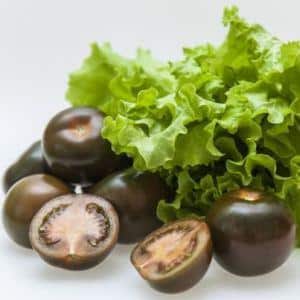
The roots grow 50 cm or more in width, without deepening.
Based on the speed of ripening, these tomatoes are classified as mid-season. The first harvest is obtained approximately 120 days after the seedlings emerge.
Cultivation is possible in both greenhouses, and in open ground.
Distinctive features and comparison with other varieties
The main distinguishing feature is, of course, the unusual color of the fruit.They are brown, dark brown, chocolate, or with a black tint.
The fruits have an equally regular round shape, which is rare in other tomato varieties.
Another feature: the seeds germinate quickly, and then the growth of seedlings slows down.
Fruit characteristics, yield
The fruits are round in shape, weighing from 75 to 180 g, quite hard. The skin is thin. The pulp is juicy, red, sometimes with a greenish tint.
Tomatoes have a rich aroma and bright taste, are rich in vitamins A and C, as well as potassium, magnesium and fructose. There are few seeds in the filling, which has a positive effect on the taste of the fruit.
Kumato is a fertile variety with high yield: up to 8 kg of fruits are collected from one bush, and from 1 sq. m. - on average 15 kg.
How to grow seedlings
It is necessary to sow seeds for seedlings in early March. Before this, you need to complete a number of points described below.
Seed preparation
Before planting, it is recommended to disinfect the seeds by soaking them for 15-20 minutes in 1% potassium permanganate solution. Then rinse the seeds with running water. These actions will help get rid of diseases that live on the surface of the seeds. Purchased material does not need to be disinfected.
You can treat the seedling material with a specialized solution to stimulate seed dew.
Container and soil
If you plan to buy soil for seedlings, choose peat soil. If you plan to prepare the soil yourself, then mix peat, humus and river sand in a ratio of 60:30:10. Add 1 cup wood ash. The soil must be disinfected from pathogens. To do this, bake it in the oven.
The optimal container is seedling boxes.In them you can care for all the sprouts at the same time and move the containers to the right place without any problems.
Sowing
Plant the seeds in depressions 1-2 cm and at a distance of 2 cm from each other. The soil should be warmed to a temperature of 22 degrees.
Carefully water the soil with the seeds with warm, settled water and cover the box with film or thin glass. This is necessary to ensure the required level of humidity.
Place the containers in a well-lit room with a temperature of +25 degrees.
Growing and care
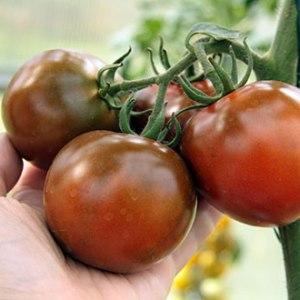 Around the fifth day, the first shoots appear. After this, the film or glass can be removed. At night, open the window for micro-ventilation, but avoid drafts.
Around the fifth day, the first shoots appear. After this, the film or glass can be removed. At night, open the window for micro-ventilation, but avoid drafts.
As soon as the first leaves appear on the sprouts, they need to be picked into separate pots. This way the plants will not interfere with each other, and the root system will develop to its full potential. When transplanting, feed with liquid nutrition.
After picking, the seedlings are watered regularly as the soil dries. Avoid stagnation of moisture.
Important! Try not to let water get on the plant itself.
Seedlings need to be fertilized twice, with an interval of 2 weeks.
In order for the seedlings to grow strong and adapt well when transplanted, they begin to harden them 2 weeks before planting. You need to take the boxes with seedlings outside for several hours every day, increasing the time slightly each day.
How to grow tomatoes
Growing the Kumato variety is quite standard. This block of the article outlines the basics for obtaining healthy tomatoes and high yields.
Landing
The first thing to start with is preparing the soil. Success in growing this variety will largely depend on its quality. The ideal option is slightly acidic loamy soil.It should be fertilized with organic fertilizers, manure, straw or compost. To normalize acidity, add lime to the soil.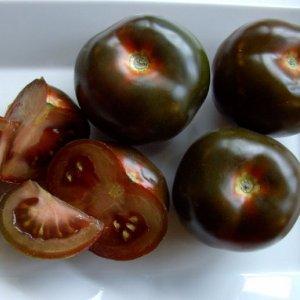
Seedlings are planted in greenhouses at the beginning of May, and in open ground much later: at the end of May or at the beginning of June. It is important that the ground is warmed up and there is no frost at night. At this point, the seedlings reach a height of 35 cm.
Each bush has approximately 8-10 leaves, the stem thickness is 0.6 cm.
Before planting the bushes, the soil is moistened, the holes are prepared, and fertilizer with phosphorus is placed at the bottom of the holes. The distance between the sprouts should be 50-60 cm. It is better to organize the planting in a checkerboard pattern.
After planting, the soil around the tomatoes is watered abundantly, the soil is loosened to allow oxygen to reach the roots and mulched with peat.
It is recommended to immediately tie the planted bushes to the support.
Plant care
Watering the plants as the top layer of soil dries, on average once every 5-7 days and always at the root. It is better to use warm, settled water.
They weed as needed; after weeding, the soil around the bushes is loosened.
Since the bushes grow greatly in height, they need staking. Only the lower and lateral processes need to be trimmed.
Bush formation is not required. The highest yield can be collected from bushes that grow 2-3 stems.
The variety is fed strictly according to schedule (once every 10 days) with mullein or other mineral fertilizers.
Features of cultivation and possible difficulties
As such, the Kumato variety does not have any growing characteristics. There is a small nuance: the stems and foliage of these plants contain glycoalkaloid substances, so you only need to use gloves when handling them, replanting and pinching.
Otherwise, the juice that is released from the leaves and stems upon contact with the skin can cause a severe allergic reaction.
Diseases and pests
The variety is resistant to the main diseases characteristic of tomatoes. However, it is worth carrying out preventive spraying against diseases and pests.
If seedlings are infected with late blight, spray them with a soap solution (use laundry soap) or a specialized commercial solution.
The soap solution will also help get rid of pests: aphids, Colorado potato beetles, slugs. If you use industrial solutions against pests, apply them to the plants before flowering.
Do not forget to ventilate the greenhouse to avoid bacterial damage.
The nuances of growing in open ground and in a greenhouse
If you are planting seedlings in a greenhouse, it is better to form bushes with 1-2 stems, otherwise the tomatoes will grow too thick and become crowded.
When the bush hits the ceiling, pinch the top. Ventilate the greenhouse, avoid extreme heat and excess moisture. Failure to comply with these rules will negatively affect the taste of tomatoes.
If you plan to grow Kumato in open ground, choose the sunniest bed. Install good supports, more than 2 m high. As soon as the plant reaches a height of 2 m, pinch the top.
Harvesting and application
The harvest ripens in early or mid-July. It is better to pick ripe fruits from the bushes immediately, so they will be stored longer and will not lose their attractive appearance. And the plant will not waste its energy on ripened tomatoes, but will use it to ripen green fruits.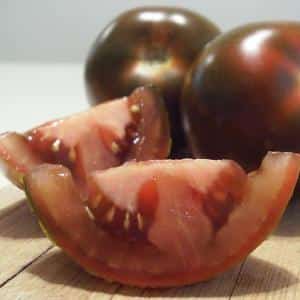
Unusual black tomatoes are good for health.This color is given to them by substances that are responsible for cell restoration and rejuvenation of the body. They also contain more vitamins and beneficial microelements than the fruits of traditional varieties. In particular, vitamin C and antioxidants.
Kumato tomatoes are perfectly stored and transported.
This variety is considered a dessert variety and is suitable for fresh consumption, in salads, and for making juices. During heat treatment, some of the beneficial properties are lost and the taste changes.
These tomatoes pair well with herbs, creamy, salty or blue cheese. Suitable as a snack with dry red wine.
Advantages and disadvantages of the variety
The main advantage of these tomatoes is their excellent taste and unique composition of nutrients, which was mentioned earlier.
There are other advantages:
- high productivity;
- sweet fruity taste;
- pleasant aroma;
- smooth, uniformly shaped fruits;
- rapid seed germination;
- fruits are well transported;
- shrubs are resistant to high temperatures and many diseases.
A conditional minus is the unusual color of the fruit. Many gardeners are skeptical about such tomatoes. But people who love everything unusual, on the contrary, consider this property an advantage.
Farmer reviews
On the forums you will find a lot of reviews about this variety. Here are some of them:
Elena, Kharkov:
“I grew tomatoes in open ground. Height 1.7 meters, weight 90 g, mid-season chocolate variety, dense, with a thick wall, very tasty, sweetness is a solid 5! The bush is very strong and high-yielding. Knits until frost. I recommend".
Nina, St. Petersburg:
“A productive variety, thick-skinned, but tasty and sweet.But I don’t want to eat it during the tomato season because of its thick skin, I would like to leave it for the fall, but it’s mid-early.”
Julija, Moscow:
“This unusual and tasty tomato variety is suitable for a variety of diets. The calorie content of the fruits of the Kumato variety is low, but the taste is high. In addition, the fruits of this variety have an unusual color, which allows you to diversify the appearance of salads. I have been growing this variety for 3 years now, cultivation is simple and does not require special knowledge. There are a lot of fruits."
Irina Seraja, Tver:
“The Kumato variety is not so often found in gardens, but those who have tried to grow them in their beds do not regret it. Delicious, aromatic fruits with a brown-red color look beautiful on the bush and in salads. I plant 5 bushes every year and the harvest is enough for the whole family.”
Farmers share these photos of Kumato tomatoes:
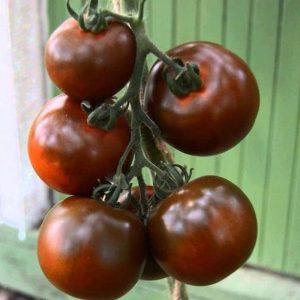
Conclusion
The beneficial properties of Kumato tomatoes are obvious; in addition, they have an unusual bright color, a special taste and a lot of other positive characteristics. The plants are easy to care for, grow well and delight farmers with an excellent harvest.
To understand and appreciate all the benefits of the variety, be sure to try growing it. These fruits, exotic in taste and appearance, will not leave anyone indifferent.